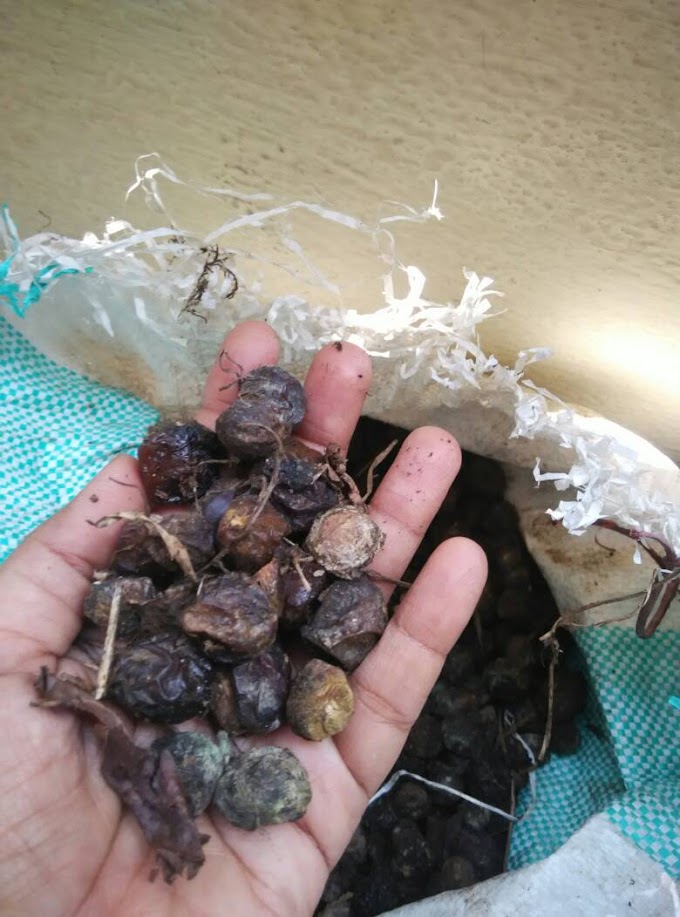I guess I heard about the term 'Seed balls' about four to five years back although the concept itself is an ancient one and have been around for much longer. Widely attributed to Masanobu Fukuoka, the man behind The One-Straw Revolution, Seed balls are a way to plant seeds without disturbing the soil layer by digging or plowing. The other reason for putting the seeds into the 'Seed ball' is to protect it from insects and birds until it can sprout and grow into a young plant.
In the last few decades, Seed balls are more prominently being used for reforestation efforts and in last few years, they have caught the fancy of urban folks as well who want to do their bit for the environment.
By concept, the Seed ball can be used to hold any kind of seeds - grains, millets, vegetables, trees....although for forestation, native tree seeds are preferred and used. In urban setups, the idea of making Seed balls of Vegetables, Flowers and other garden plants is quickly becoming a trend and even becoming an option for Green gifting. Very soon, there might come a day when people give Seed ball boxes instead of Sweet boxes to their near and dear ones during Diwali :) One can wish ;)
Alright - so, now onto how to make the Seed ball. The internet is filled with so many different ways and methods to do Seed balls - from how to make it, how to throw it, and how to store it! Here's a video of the man himself showing how to make Seed balls - https://www.youtube.com/watch?v=A4-bwW8PWI0
Here's a very simple method I follow:
You can even make Seed balls from old waste papers and newspapers. Simply replace the red soil and clay with mashed, wet paper, add equal parts compost and voila, your paper seed ball is ready. They can even be made into lovely shapes using moulds.
In the last few decades, Seed balls are more prominently being used for reforestation efforts and in last few years, they have caught the fancy of urban folks as well who want to do their bit for the environment.
By concept, the Seed ball can be used to hold any kind of seeds - grains, millets, vegetables, trees....although for forestation, native tree seeds are preferred and used. In urban setups, the idea of making Seed balls of Vegetables, Flowers and other garden plants is quickly becoming a trend and even becoming an option for Green gifting. Very soon, there might come a day when people give Seed ball boxes instead of Sweet boxes to their near and dear ones during Diwali :) One can wish ;)
Alright - so, now onto how to make the Seed ball. The internet is filled with so many different ways and methods to do Seed balls - from how to make it, how to throw it, and how to store it! Here's a video of the man himself showing how to make Seed balls - https://www.youtube.com/watch?v=A4-bwW8PWI0
Here's a very simple method I follow:
- Take equal parts Red Soil (i.e. regular planting soil available near you), Clay (if in powder or dry form, it's better) and Cow Dung/Compost. If using Cow dung, again if it is semi-dry its good and hopefully a desi cow dung if available. But it doesn't matter - the reason for adding Cow dung/compost is just to give nutrition to the young plant when it first sprouts as we won't know its environmental condition where we throw it.
- Get together the red soil, clay and cow dung together into a smooth mix without any lumps. Use water to get a holding consistency (almost like a chapathi but a bit more drier if you will) - but dont use too much water as it will take a long time to dry.
- Now, you can either mix up all your seeds into the above mix evenly OR opt to put in select number of seeds into the ball once you make them. If you are putting the seeds directly into the mix before making the Seed ball, just ensure you use enough/sufficient quantity of seeds such that each Seed ball may hold atleast a few. Usually, if we use this method, we use dry clay and at least 20 - 40% of seeds (to the overall soil quantity) and mix them up before adding water.
- Once your mix is ready and of right holding consistency (test it by trying to make a ball), mould/shape them into small ladoo shaped balls. You can even use fancy baking moulds to get different shapes if you desire/gift to children. It's important that your Seed ball is not too big (unless you are using BIG seeds like Mango). The Seed ball (especially if you are going to place the seeds inside after shaping to balls) size should be relative to the size of the seeds.
- Now, in each of the shaped ball, gently insert the seeds you have selected and push them inside such that it is completely covered by the mix. Roll it between your hands to ensure there are no cracks and surface is even.
- Spread them on the ground/cloth and let it dry under gently sun or shade for next few days. Once completely dry, they are ready to be used!
Gift them, throw them or simply Grow them in your gardens!
You can even make Seed balls from old waste papers and newspapers. Simply replace the red soil and clay with mashed, wet paper, add equal parts compost and voila, your paper seed ball is ready. They can even be made into lovely shapes using moulds.







0 Comments